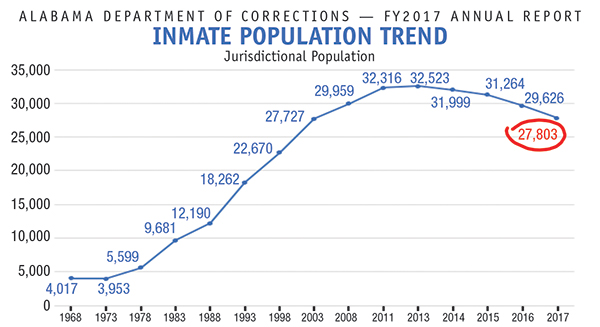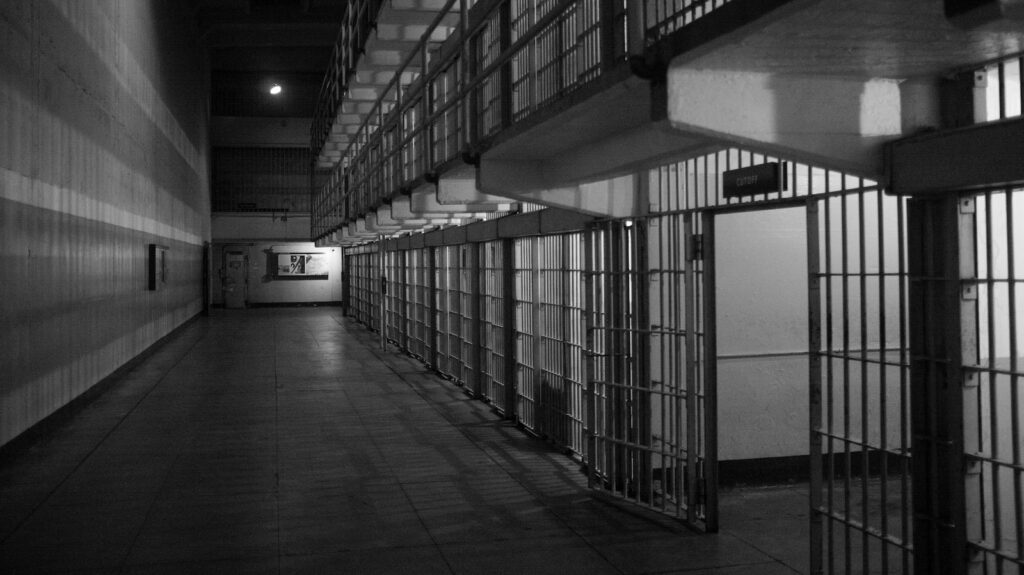By Carrie Brown McWhorter
The Alabama Baptist
Alabama’s incarceration rate continued a four-year declining trend in 2017, mirroring a decline in the prison population nationally.
The 2017 annual report of the Alabama Department of Corrections (ADOC) noted a 15 percent overall reduction in the state prison population during fiscal year 2017 running from Oct. 1, 2016, to Sept. 30, 2017. During that period, 27,803 inmates were in the state’s jurisdictional population, which includes all inmates sentenced to the ADOC and those housed in ADOC facilities, community corrections, federal, other states and county jail custody. The state’s in-house population, which includes only inmates housed in a facility owned and operated by ADOC, was 21,213 during fiscal year 2017. Alabama’s prison population reached a high of 32,523 in 2013.
In the report, ADOC Commissioner Jefferson Dunn noted sentencing reforms as the primary reason for the decline.
Pew Research released an analysis on U.S. incarceration rates in May, citing new data from the Bureau of Justice Statistics (BJS), the statistical arm of the Department of Justice. The BJS data indicates the U.S. incarceration rate is at its lowest level in 20 years, writes Pew editor John Gramlich.
At the end of 2016 there were about 2.2 million people behind bars in the U.S., including 1.5 million under the jurisdiction of federal and state prisons and roughly 741,000 in the custody of locally run jails. That amounts to a nationwide incarceration rate of 860 inmates for every 100,000 adults ages 18 and older, according to Pew’s analysis.
The nation’s incarceration rate peaked at 1,000 inmates per 100,000 adults during the three-year period between 2006 and 2008. It has declined every year since then and is now at its lowest point since 1996, when there were 830 inmates per 100,000 adults.
The number of inmates in the U.S. has also gone down in recent years, though not as sharply as the incarceration rate (which takes population change into account). The estimated 2,162,400 inmates who were in prison or jail at the end of 2016 were the fewest since 2004, when there were 2,136,600 inmates.
The U.S. still incarcerates a larger share of its population than any other country. According to Prison Policy Initiative (PPI), an advocacy group that supports criminal justice reform, the U.S. has the highest incarceration rate in the world based on data from 2014 to 2016. PPI’s analysis reports a U.S. incarceration rate of 693 people for every 100,000 residents.
The nation with the second highest incarceration rate in the world after the U.S. is Turkmenistan, a country that Human Rights Watch calls one of the world’s “most repressive and closed countries” for its ruthless punishment of any political or religious expression that opposes the government.
According to PPI’s 2016 report of world incarceration rates, Alabama ranks 5th in the United States with 987 incarcerated persons for every 100,000 residents, behind the District of Columbia, Louisiana, Georgia and Oklahoma.
According to data analysis by World Prison Brief, rates in Western Europe are less than a quarter of the U.S. rate. In England there are 142 inmates for every 100,000 people, while Germany incarcerates 77 people for every 100,000 residents.
‘The big picture’
PPI co-founder Peter Wagner in a report titled “Mass Incarceration: The Whole Pie 2018” argues that mass incarceration reform must include conversations between federal and state officials on issues of sentencing, money bail reform and racial, ethnic and income disparities in the criminal justice system.
“The big picture is important,” Wagner says, noting that many criminal justice reforms of the past simply move people from one part of the system to another. “Ending mass incarceration means shrinking the size of the entire ‘pie’ and not just rearranging where people are held within it.”






Share with others: